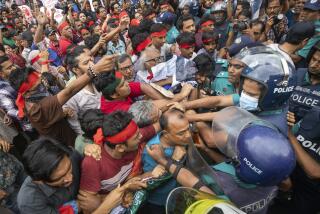China tortured, killed Tibetans in 2008 crackdown, rights group says
- Share via
Reporting from Beijing — For offenses as minor as printing a Tibetan flag, sending a text message about rioting or holding a photograph of the Dalai Lama, large numbers of Tibetans were badly beaten and tortured, and in some cases killed, by Chinese security forces in 2008, a human rights group reported Thursday.
In the most comprehensive report yet on the crackdown on Tibetans during and after March 2008 protests, the most serious in decades, New York-based Human Rights Watch interviewed 203 people described as Tibetan eyewitnesses.
“The scale of human rights violations related to suppressing the protests was far greater than previously believed,” the report states. “Chinese forces broke international law — including prohibitions against disproportionate use of force, torture and arbitrary detention.”
Human Rights Watch was not able to provide hard numbers beyond the Chinese government’s statements that there had been hundreds of arrests in Lhasa, the Tibetan capital, and elsewhere.
The Chinese government had no immediate comment on the report, but it has maintained that its forces acted with restraint in the face of widespread looting, arson and attacks against Han Chinese by Tibetans. The government says about 20 people were killed in Lhasa and that none of the deaths were attributable to security forces.
But the Human Rights Watch report presents anecdotes and testimony suggesting widespread abuse of monks and others who were taken away by the truckloads after the riots.
In one example, a 33-year-old Buddhist monk from Ganden Monastery told the human rights group about beatings at three different detention centers near Lhasa. “The night we arrived, the guards made us lie face down and interrogated us again. They beat our buttocks with sand-filled tubes.”
The senior monk at Labrang Monastery, Jigme Gyatso, in a videotaped statement to a Tibetan group, said he was handcuffed, beaten, hung by his wrists to pressure him to acknowledge connections with “educated people and high Tibetan clerics” abroad and other offenses. After six days in the hospital, where he says he was on the verge of death, he was released to his family — but only after putting his “thumbprint on a letter acknowledging that I was not beaten.”
In an assertion that is likely to be among the most contested in the Human Rights Watch report, witnesses describe several incidents in which Chinese forces fired live ammunition at unarmed demonstrators.
The allegations are impossible to verify as Lhasa and many Tibetan-populated areas have been virtually locked down since the 2008 riots. Journalists have been permitted into Lhasa only on government-escorted tours where they are tightly monitored and forbidden to speak freely with residents.
Human Rights Watch urged the Chinese government to allow a serious examination of what happened in March 2008 and to provide an accounting of what happened to several hundred Tibetan detainees who remain missing more than two years later.
More to Read
Sign up for Essential California
The most important California stories and recommendations in your inbox every morning.
You may occasionally receive promotional content from the Los Angeles Times.













